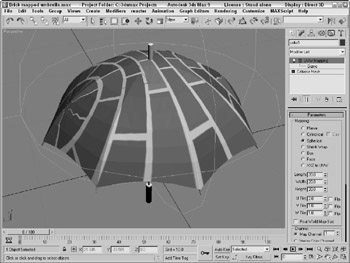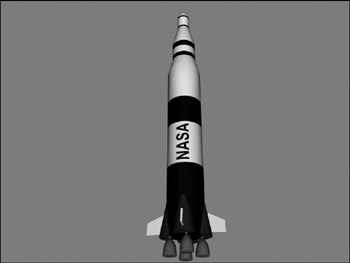Chapter 24: Unwrapping UVs and Pelt Mapping
Throughout the modeling chapter, as you created objects, the Generate Mapping Coordinates option appeared for almost all objects. So now you finally get to find out what mapping coordinates are and how to use them.
Mapping coordinates are used to define how a texture map is aligned to an object. These coordinates are expressed using U, V, and W dimensions, with U being a horizontal direction, V being a vertical direction, and W being depth.
When you enable the Generate Mapping Coordinates option for new objects, Max takes its best guess at where these coordinates should be located. For example, a Box primitive applies a texture map to each face. This works well in some cases, but you won't have to wait long until you'll want to change the coordinates.
Control over the mapping coordinates is accomplished using many different modifiers, including the granddaddy of them all-UVW Unwrap.
Mapping Modifiers
Among the many modifiers found in the Modifiers menu are several that are specific to material maps. These modifiers are mainly found in the UV Coordinates submenu and are used to define the coordinates for positioning material maps. These modifiers include the UVW Map, UVW Mapping Add, UVW Mapping Clear, UVW XForm, MapScaler (WSM), Projection, Unwrap UVW, Camera Map (WSM), and Camera Map.
| CROSS-REF | The Projection modifier is used to create normal maps and is covered in Chapter 25, "Creating Baked Textures and Normal Maps." |
UVW Map modifier
The UVW Map modifier lets you specify the mapping coordinates for an object. Primitives, Loft Objects, and NURBS can generate their own mapping coordinates, but you need to use this modifier to apply mapping coordinates to mesh objects and patches.
| Note | Objects that create their own mapping coordinates apply them to Map Channel 1. If you apply the UVW Map modifier to Map Channel 1 of an object that already has mapping coordinates, then the applied coordinates overwrite the existing ones. |
You can apply the UVW Map modifier to different map channels. Applying this modifier places a map gizmo on the object. You can move, scale, or rotate this gizmo. To transform a UVW Map gizmo, you must select it from the subobject list. Gizmos that are scaled smaller than the object can be tiled.
Many different types of mappings exist, and the parameter rollout for this modifier lets you select which one to use. The Length, Width, and Height values are the dimensions for the UVW Map gizmo. You can also set tiling values in all directions.
The Alignment section offers eight buttons for controlling the alignment of the gizmo. The Fit button fits the gizmo to the edges of the object. The Center button aligns the gizmo center with the object's center. The Bitmap Fit button opens a File dialog box where you can align the gizmo to the resolution of the selected bitmaps. The Normal Align button lets you drag on the surface of the object, and when you release the mouse button, the gizmo origin is aligned with the normal. The View Align button aligns the gizmo to match the current viewport. The Region Fit button lets you drag a region in the viewport and match the gizmo to this region. The Reset button moves the gizmo to its original location. The Acquire button aligns the gizmo with the same coordinates as another object.
Figure 24.1 displays a brick map applied to an umbrella using spherical mapping.

Figure 24.1: The UVW Map modifier lets you specify various mapping coordinates for material maps
Tutorial: Using the UVW Map modifier to apply decals
After mapping coordinates have been applied either automatically or with the UVW Map modifier, you can use the UVW XForm modifier to move, rotate, and scale the mapping coordinates.
Most objects can automatically generate mapping coordinates-with the exception of meshes. For meshes, you need to use the UVW Map modifier. The UVW Map modifier includes seven different mapping options. Each mapping option wraps the map in a different way. The options include Planar, Cylindrical, Spherical, Shrink Wrap, Box, Face, and XYZ to UVW.
In this tutorial, we use the UVW Map modifier to apply a decal to a rocket model. Zygote Media created the rocket model.
To use the UVW Map modifier, follow these steps:
-
Open the
 Nasa decal on rocket.max file from the Chap 24 directory on the DVD.
Nasa decal on rocket.max file from the Chap 24 directory on the DVD.This file includes a model of a rocket with the appropriate materials applied. The Chap 24 directory on the DVD also includes a 300 × 600 image of the word NASA in black capital letters on a white background. The background color of this image was set to be transparent, and the image was saved as a .GIF.
Note The GIF format, typically used for Web pages, can easily make areas of the image transparent. These transparent areas become the alpha channel when loaded into Max.
-
Open the Material Editor (or press the M key), and select the first sample slot. Name the material NASA Logo. Click the Diffuse color swatch, and select a white color. Then click the map button to the right of the Diffuse color swatch, and from the Material/Map Browser, double-click the Bitmap map. Locate the NASA image from the Chap 24 directory on the DVD, and click Open. The bitmap image loads, and the Bitmap parameters display in the rollouts. In the Coordinates rollout, enter a value of −90 in the W Angle field. The letters rotate vertically. Then, in the Bitmap Parameters rollout, select the Image Alpha option.
-
Select the lower white section of the rocket in the viewport, and open the Modify panel. At the top of the Modify panel, click the Modifier List and select the UVW Map modifier. Select the Cylindrical Mapping option, but don't select the Cap option in the Parameters rollout.
-
With the cylinder section selected, open the Material Editor again, select the first sample slot, and click the Assign Material to Selection button.
| Tip | When a bitmap is applied to an object using the UVW Map modifier, you can change the length, width, and tiling of the bitmap using the UVW Map manipulator. If you enable the Select and Manipulate button on the main toolbar the manipulator appears as green lines. When you move the mouse over the top of these green lines, they turn red, and you can drag them to alter the map dimensions. Use the small green circles at the edges of the map to change the tiling values. As you use the manipulator, the map is updated in real time within the viewports if you have enabled the Show Map in Viewport option in the Material Editor. |
Figure 24.2 shows the resulting rendered image.

Figure 24.2: You can use the UVW Map modifier to apply decals to objects
UVW Mapping Add and Clear modifiers
The UVW Mapping Add and the UVW Mapping Clear modifiers are added to the Modifier Stack when you add or clear a channel using the Channel Info utility. More on this utility is covered in Chapter 25, "Creating Baked Textures and Normal Maps."
UVW XForm modifier
The UVW XForm modifier enables you to adjust mapping coordinates. It can be applied to mapping coordinates that are automatically created or to mapping coordinates created with the UVW Map modifier. The parameter rollout includes values for the UVW Tile and UVW Offsets. You can also select the Map Channel to use.
Map Scaler modifier
The Map Scaler modifier is available as both an Object-Space modifier and a World-Space modifier. The World-Space version of this modifier maintains the size of all maps applied to an object if the object itself is resized. The Object-Space version ties the map to the object, so the map scales along with the object. The Wrap Texture option wraps the texture around the object by placing it end-to-end until the whole object is covered.
Camera Map modifier
The Camera Map modifier creates planar mapping coordinates based on the camera's position. It comes in two flavors-one applied using Object-Space and another applied using World-Space.
The single parameter for this modifier is Pick Camera. To use this modifier, click the Pick Camera button and select a camera. The mapping coordinates are applied to the selected object.